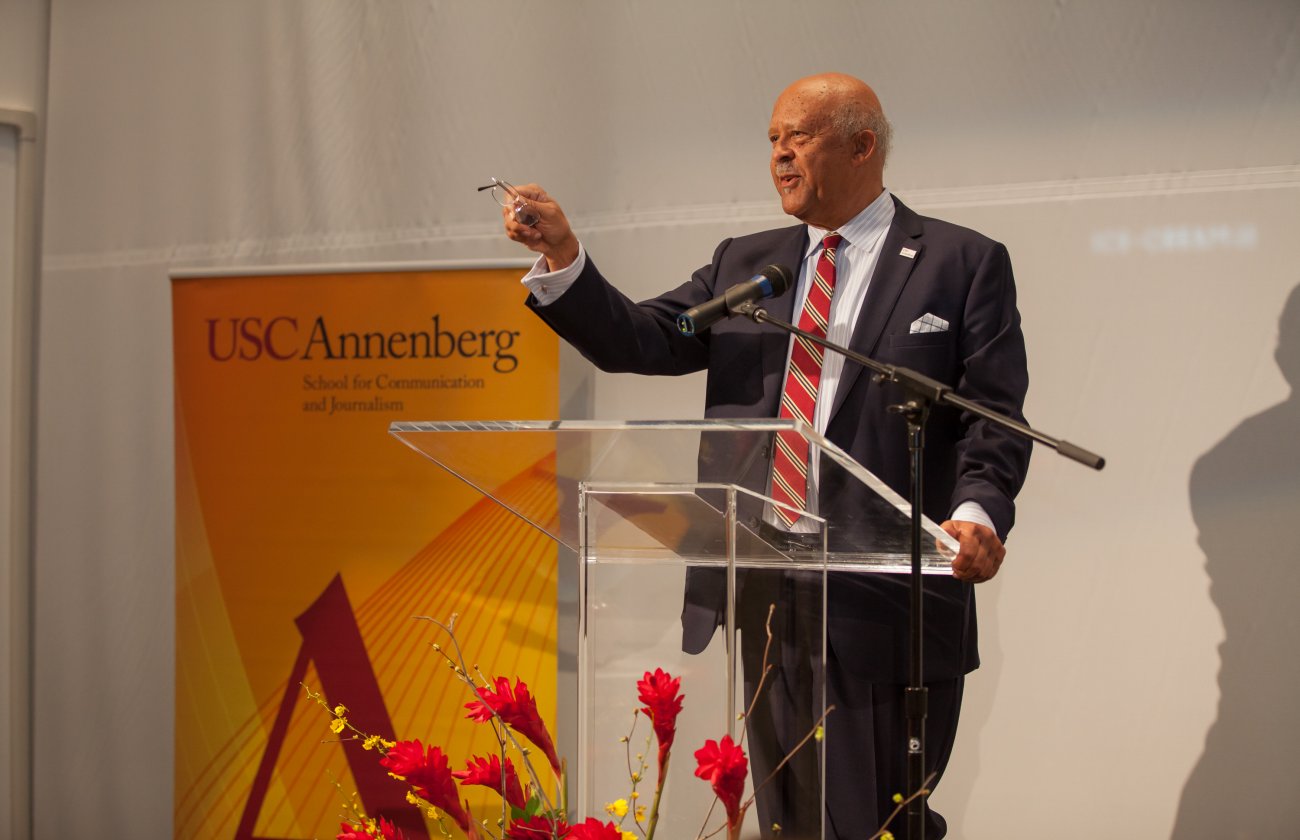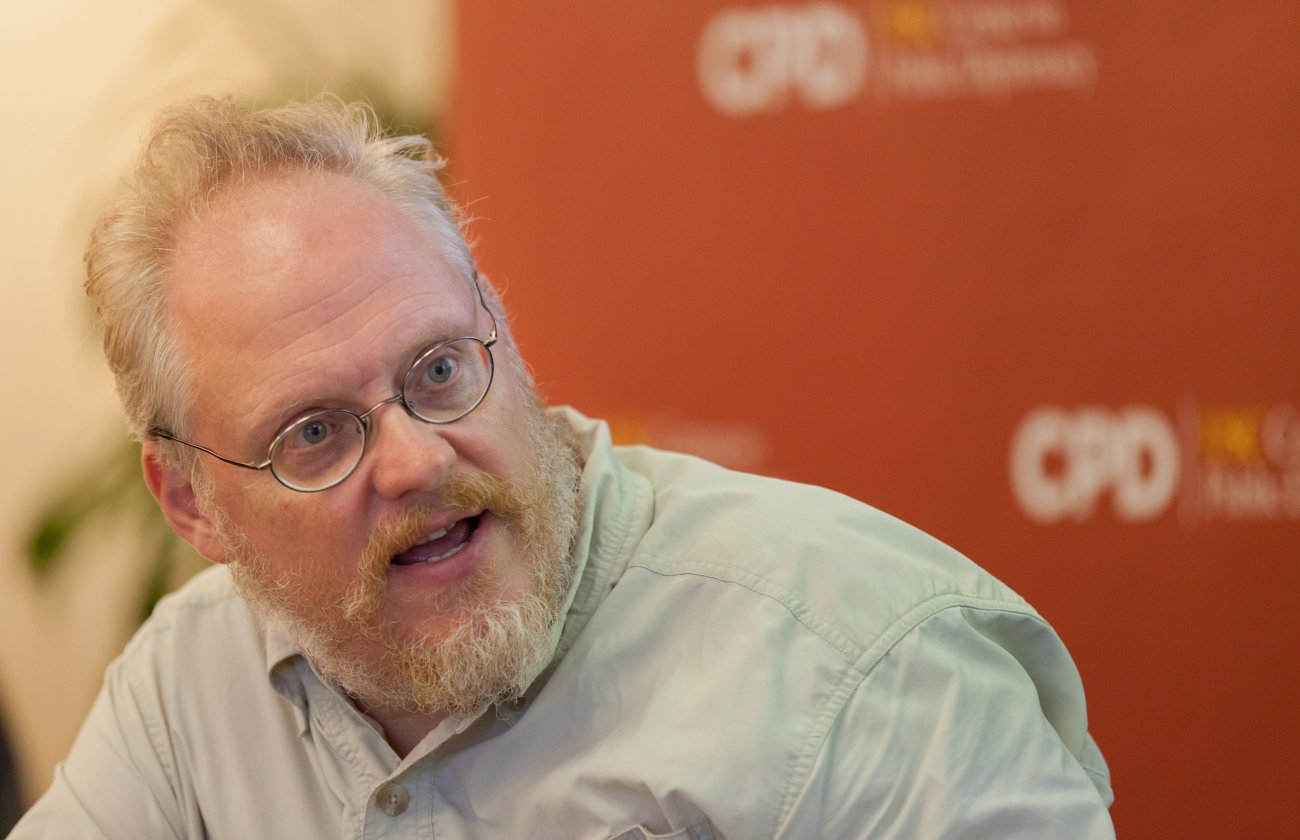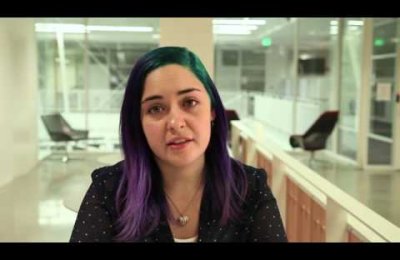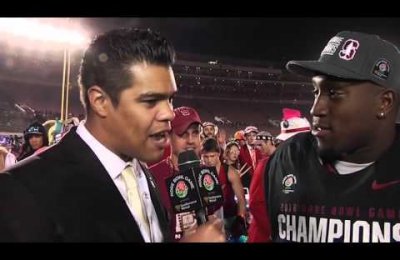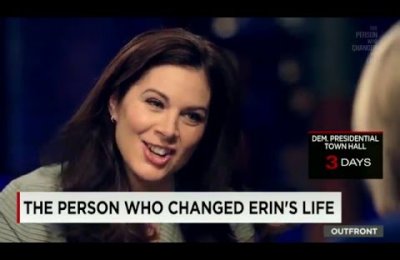USC Annenberg hosts "Drawing Conclusions: The Editorial Cartoon" through May 17, 2013 outside Room 207 on the second floor.
By Jeremy Rosenberg
Robert Scheer is ecstatic.
The celebrated author, journalist, weekly public radio show panelist and USC Annenberg communication professor has been reciting a quote by the late, legendary journalist, A.J. Liebling.
Then, in just the time it takes for a web page to load, Scheer's voice rises an octave or two as he sees an online illustration.
"Oh, God!" Scheer says, checking the homepage of Truthdig.com, the site he edits. "Fish is so brilliant. Are you looking at that?"
The reason for Scheer's exclamation is as old as a cave painting: The power of great art.
Or, as Mr. Fish (also known as Dwayne Booth) would say a few days later, unaware of Scheer's reaction: "That's really the purpose of a good cartoon, anyway. You want to shock somebody or make them laugh in such a way that they want to show it to somebody else."
Mr. Fish is an award-winning, Philadelphia-based editorial cartoonist whose work rivets Scheer and so many others. He is a multiple winner of the Society of Professional Journalists' award for editorial cartooning.
Mr. Fish's pieces are a watchdog's intense blend of searing texts; savage wit; sometimes simple doodles; and as exemplified by the illustration that accompanies this story, other times highly realistic fine art drawings featuring painstakingly rendered faces and figures.
"He's more than a cartoonist," USC Annenberg Vice Dean and School of Communication Director Larry Gross says of Mr. Fish, whose works have also appeared in publications such as Harper's, Vanity Fair and LA Weekly. "To the extent there is some sort of adjacency between cartooning and graphic art, he's on the border. Fish is a more complex character."
Booth, Scheer and Gross – and a host of others – have collaborated to create and present, "Drawing Conclusions: The Editorial Cartoon." This exhibition, curated by Booth, is scheduled to open with a reception the evening of Oct. 24.
The show hangs outside USC Annenberg Room 207 and features approximately 70 drawings by some of America's most critical-thinking and creative cartoonists.
These include the late, Los Angeles Times lion of the profession, Paul Conrad; Conrad's replacement, the exquisite draftsperson, Michael Ramirez; David Rees of "Get Your War On" fame; Joe Sacco; the Washington Post's Ann Telnaes – formerly a Disney illustrator; Doonesbury's Gary Trudeau and the underground figure, Ron Cobb.
Sixteen of the artists are highlighted in wall displays designed by Booth. These displays feature the artists explaining – via words and images – their respective influences, whomever and whatever they may be. "I do cartoons, but none of my heroes are cartoonists," Booth says. "They are all from different disciplines."
"Drawing Conclusions" is co-sponsored by the Future of Journalism Foundation, a project of Community Partners. The FJF is a non-profit formed by Scheer as well as Gross and University Professor and former USC Annenberg Dean Geoffrey Cowan.
"The mission of FJF," according to text provided by Maran Smith, a USC Annenberg visiting scholar and the Foundation's coordinator, "is to help advance a democratic society by producing independent, credible, in-depth journalism that informs the public about important issues that are not being sufficiently covered by other news organizations, by distributing this journalism in the public domain, and by generating this reporting via hands-on mentorships of young journalists by senior reporters, thus also building future capacity for high-quality journalism in the public interest."
Scheer and Gross are both longtime fans of editorial cartooning. Scheer conceived the idea for the exhibition in part thanks to the "tremendous traffic" that the cartoons by Mr. Fish and others receive on Truthdig, as well as the other online opportunities for the distribution of the work.
"Finally, we have some good news," Scheer says of a profession – cartooning – and an industry – journalism – that have been through a turbulent recent stretch. "I don't see this (exhibition and planned related programming) as an obituary for political cartooning. I see that it has a vivid history, and then say, hey, we can go on."
Gross says that political cartooning has always been "an important, but somehow under-noticed aspect of journalism." The Vice Dean, among other specialties, is an expert in image integrity whose office bookshelves brim with art history volumes.
Cartoons have an ancient history, Gross says. "We have examples going back thousands of years, as a way of making a rapid and often very powerful public statement," he says. "It's a way to affix an argument or a position or a point to a public audience."
Adds Gross: "It's been observed by many people that an incisive, humorous criticism often sticks much more than any other kind. It can become the tag that's very hard for the target to erase. People remember. It's a very powerful weapon."
During a recent phone call with Mr. Fish, the conversation about the power of cartoons careens from the scatological to the sacred. From President Obama to Governor Romney. From pajamas to the Genius Bar. From Art Spiegelman to Richard Nixon to Voltaire.
From the latter, an 18th century French Enlightenment philosopher, Mr. Fish recites a version of a classic quote that the artist says could serve as an editorial cartoonist's job description: "It is dangerous to be right when the government is wrong."
Read Mr. Fish's Truthdig.com essay about "Drawing Conclusions."

